Abstract
Ultra-precision machining has been well known as a very precise and effective way to prototype and fabricate different types of components with microstructures. In this paper, an ultra-precision micro-milling method has been presented to produce a micro-step pillar array as an embossing mold for semiconductor application. Theoretical analysis on machining mechanics indicates that work material property, machining strategy, and cutting tool geometry largely affect machining distortion on the machined microstructure. Experimental investigation has been conducted on micromachining of the micro-step pillar array using different types of cutting tools and work materials. Experimental results demonstrate that the material property, cutting tool edge radius, and cutting force play a significant role in the machined micro-structure accuracy and surface finish, while grain boundary of brass has no significant effect on the micro-milling performance. The best outcome among the tests done is achieved when using brass as work material and cutting with a straight-edge single crystalline diamond tool. The main reasons to achieve this outcome are based on: the brass material having a higher elastic modulus and the diamond tool having a smaller cutting edge radius, which contributes to better machinability of brass. One micro-step pillar array has been successfully obtained with very precise feature and dimensional accuracy using brass work material and single-crystal diamond tool. It is believed that the outcomes of this study would largely benefit the research community and end-users.












Similar content being viewed by others
References
Fang FZ, Zhang N, Guo DM, Yamamura K, Cheung B, Liu K, Ehmann K (2019) Towards atomic and close-to-atomic scale manufacturing. Int J Extreme Manuf 1(1):012001
Zhang ZY, Yan JW, Kuriyagawa T (2019) Manufacturing technologies toward extreme precision. Int J Extreme Manuf 1(2):022001
Fang FZ, Liu K, Kurfess TR, Lim GC (2006) Tool-based micro machining and applications in MEMS. In: Leondes CT (ed) MEMS/NEMS handbook: techniques and applications. Springer, Boston, pp 678–840
Chae J, Park SS, Freiheit T (2006) Investigation of micro-cutting operation. Int J Mach Tools Manuf 46(3–4):313–332
O’Hara J, Fang FZ (2019) Advances in micro cutting tool design and fabrication. Int J Extreme Manuf 1(3):032003
Fang FZ, Xu FF (2018) Recent advances in micro/nano-cutting: effect of tool edge and material properties. Nanomanuf Metrol 1(1):4–31
Fang FZ, Liu YC (2004) On minimum exit-burr in micromachining. J Micromech Microeng 14(7):984–988
Liu K, Li XP, Rahman M, Neo KS, Chan CC, Liu XD (2007) A study of the effect of tool cutting edge radius on ductile cutting of silicon wafers. Int J Adv Manuf Technol 32(7–8):631–637
Woon KS, Rahman M, Neo KS, Liu K (2008) The effect of tool edge radius on the contact phenomenon of tool-based micromachining. Int J Mach Tools Manuf 48(12–13):1395–1407
Woon KS, Rahman M, Fang FZ, Neo KS, Liu K (2008) Investigation of tool edge radius effect in micromachining: a FEM simulation approach. J Mater Process Technol 195(1–3):204–211
Fang FZ, Xiong Z, Hu XT (2006) An experimental study on micromachining of micro-mirrors for laser-diode beam shaping. J Micromech Microeng 16(2):214–218
Ding X, Lim GC, Cheng CK, Butler DL, Shaw KC, Liu K, Fong WS (2008) Fabrication of micro size diamond tool using focused ion beam. J Micromech Microeng 18(7):075017
Brinksmeier E, Reese S, Klink A, Langenhorst L, Lubben T, Meinke M, Meyer D, Riemer O, Solter J (2018) Underlying mechanisms for developing process signatures in manufacturing. Nanomanuf Metrol 1(4):193–208
Arefin S, Zhang XQ, Kumar AS, Liu K, Neo WK (2019) An analytical model for determining the shear angle in 1D vibration-assisted micro machining. Nanomanuf Metrol 2(4):199–214
Takahata K, Gianchandani YB (2002) Batch mode micro-electro-discharge machining. J Microelectromech Syst 11(2):102–110
Reynaerts D, Meeusen W, van Brussel H, Reyntjens S, Puers R (1999) Production of seismic mass suspensions in silicon by electro-discharge machining. J Micromech Microeng 9(2):206–210
Moon YH, Lee ES, Park JW (2002) A study on electrochemical micromachining for fabrication of microgrooves in an air-lubricated hydrodynamic bearing. Int J Adv Manuf Technol 20(10):720–726
Masuzawa T, Kuo CL, Fujino M (1994) A combined electrical machining process for micronozzle fabrication. Ann CIRP 43(1):189–192
Davoudinejad A, Cai YK, Pedersen DB, Luo XC, Tosello G (2019) Fabrication of micro-structured surfaces by additive manufacturing, with simulation of dynamic contact angle. Mater Des 176:107839
Zheng HY, Liu K (2015) Machinability of engineering materials. In: Nee AYC (ed) Handbook of manufacturing engineering and technology. Springer, London, pp 899–939
Hibbeler RC (2007) Engineering mechanics statics. Pearson, New York, pp 117–152
Li XP, Rahman M, Liu K, Neo KS, Chan CC (2003) Nano-precision measurement of diamond tool edge radius for wafer fabrication. J Mater Process Technol 140(1–3):358–362
Wang ZF, Sun T, Zhang HJ, Li G, Li ZQ, Zhang JJ, Yan YD, Hartmaier A (2019) The interaction between grain boundary and tool geometry in nanocutting of a bi-crystal copper. Int J Extreme Manuf 1(4):045001
Author information
Authors and Affiliations
Corresponding author
Rights and permissions
About this article
Cite this article
Liu, K., Wu, H., Huang, R. et al. Ultra-precision Machining of Micro-step Pillar Array Using a Straight-Edge Milling Tool. Nanomanuf Metrol 3, 260–268 (2020). https://doi.org/10.1007/s41871-020-00076-1
Received:
Revised:
Accepted:
Published:
Issue Date:
DOI: https://doi.org/10.1007/s41871-020-00076-1




